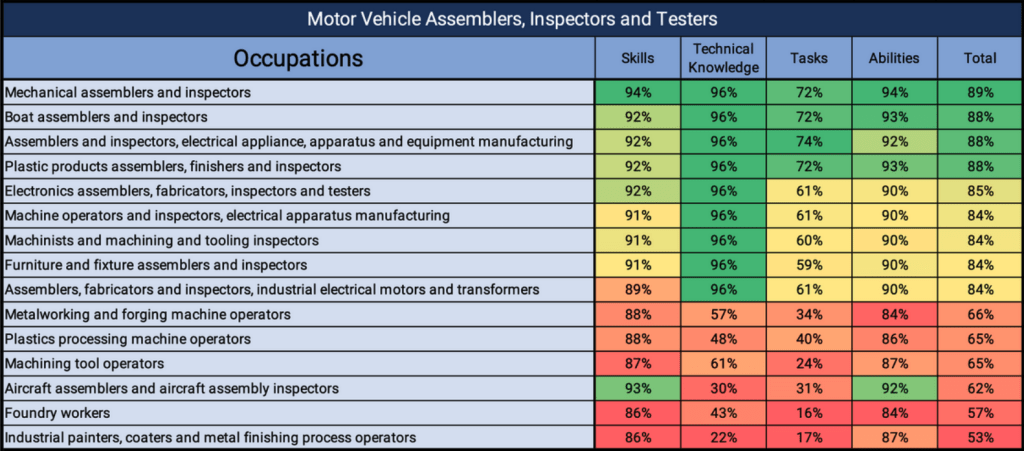Skills Transferability Matrix: Motor Vehicle Assemblers, Inspectors and Testers
Motor Vehicle Assemblers, Inspectors and Testers are production line workers who are versed in key aspects of manufacturing such as quality control analysis and operations monitoring.
Despite being an entry-level position, vehicle assemblers frequently interact with technology and software used by professionally trained skilled trades workers. The closeness of tasks and general skill set with other assemblers makes it easy for motor vehicle assemblers to transition to other areas of manufacturing, and with additional training to skilled trades and other production jobs.
Skills
Skills are developed through training and experience, and are the practical proficiencies someone possesses. The following are top key skills motor vehicle assemblers employ in their work:
- Quality Control Analysis
- Time Management
- Operation Monitoring
- Critical Thinking
- Coordination
Technical Knowledge
Technical Knowledge is the understanding of theory and utility of modern tools in a work environment. The following tools are used by motor vehicle assemblers regularly:
- Computer-aided design and manufacturing software
- Enterprise resource planning software
- Industrial control software
- Analytical or scientific software
- Process mapping and design
Tasks
Tasks are the assigned duties that an occupational group performs in their daily work. The following are the tasks motor vehicle assemblers most regularly encounter:
- Mark products, workpieces, or equipment with identifying information.
- Notify others of equipment repair or maintenance needs.
- Connect electrical components or equipment.
- Read work orders or other instructions to determine product specifications or materials requirements.
- Inspect electrical or electronic systems for defects.
Abilities
Abilities refer to the innate faculties that allow workers to carry out tasks and activities. The following are the top abilities that motor vehicle assemblers possess:
- Manual Dexterity
- Information Ordering
- Problem Sensitivity
- Visualization
- Deductive Reasoning
Skills Transferability Matrix
FOCAL’s Skills Transferability Matrices analyze the transferability of an occupation across a
multitude of other occupations on the basis of similarities in skills, technical knowledge, tasks, and abilities
as outlined by the O*Net database. It aims to show workers how to leverage their skill set in changing occupations, planning a career path, and transitioning to other industries. It also assists policy makers and educators address changing skill sets and areas of opportunity for workforce entrants in developing industries. Employers can also use this tool in reskilling or upskilling workers to circumvent skills shortages, and reduce the hiring and training challenges.

After scanning over 2,600 skills, technical competencies, tasks, and abilities of each of the 500 occupations as defined by the National Occupational Classification (NOC) system, a skills transferability matrix for motor vehicle assemblers, inspectors and testers is produced. In the matrix above, a high score is highlighted in green and indicates the high transferability potential of an attribute of an occupation with that of motor vehicle assemblers. Lower or no
transferability areas are marked in red. Motor vehicle assemblers were found to share transferable attributes with many other assembly and inspection roles, such as furniture, electrical, electronic, and boat assemblers. An overlap can also be found in the attributes of machining and tooling occupations, suggesting a potential career path way into skilled trade work. Motor vehicle assemblers may also transition into other manufacturing occupations, such as roles in metalworking, painting and coating, and machine operation.
To learn more about developments, trends and new technologies in Canada’s automotive manufacturing industry, visit our website futureautolabourforce.ca. You can also check our social media by following these links: LinkedIn, Facebook, Twitter and Instagram.

